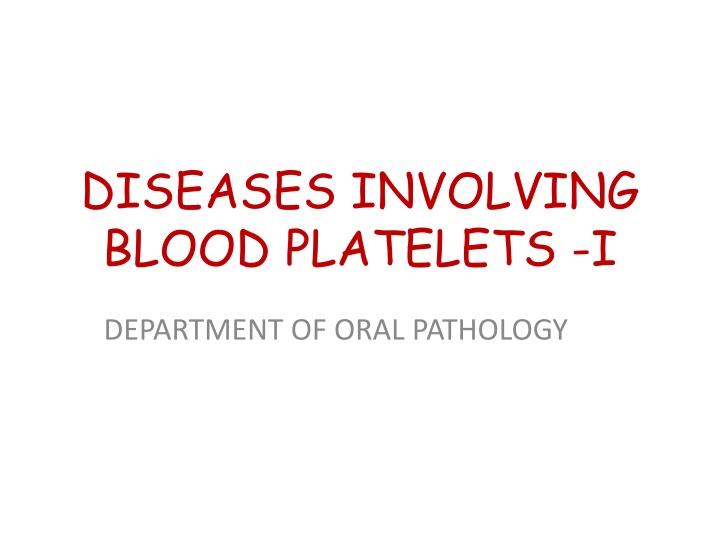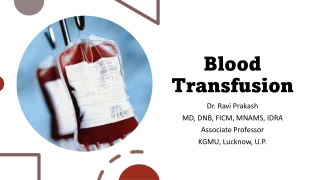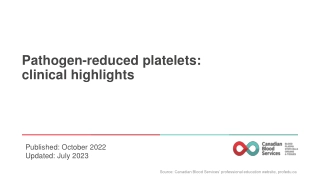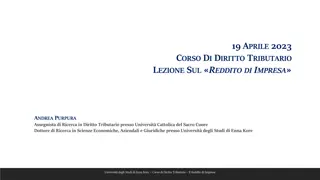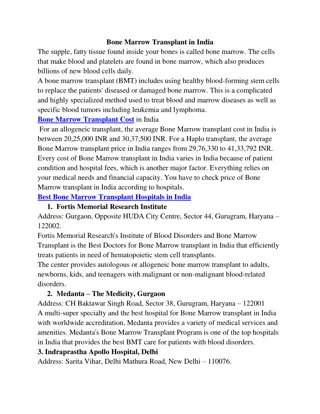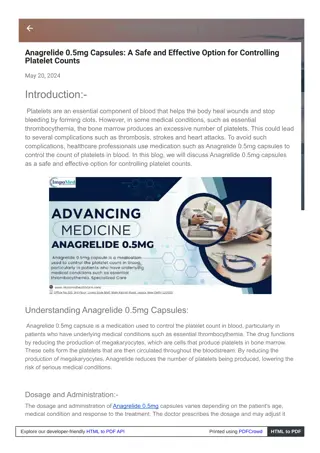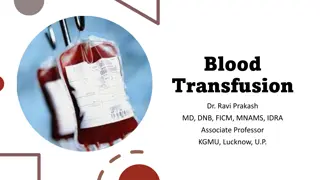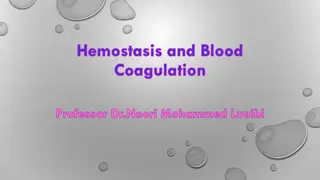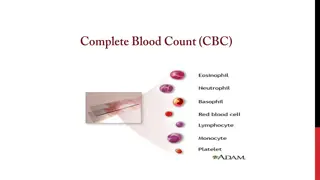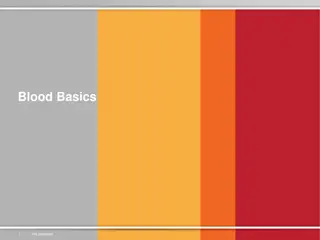Diseases Involving Blood Platelets: Overview of Purpura
Platelets, or thrombocytes, play a crucial role in hemostasis and clot formation. Learn about purpura, its types, classification, clinical features, and treatment options in this informative lecture from the Department of Oral Pathology. 2. Tags: Platelets, Purpura, Blood disorders, Oral pathology, Thrombocytopenic
Download Presentation

Please find below an Image/Link to download the presentation.
The content on the website is provided AS IS for your information and personal use only. It may not be sold, licensed, or shared on other websites without obtaining consent from the author.If you encounter any issues during the download, it is possible that the publisher has removed the file from their server.
You are allowed to download the files provided on this website for personal or commercial use, subject to the condition that they are used lawfully. All files are the property of their respective owners.
The content on the website is provided AS IS for your information and personal use only. It may not be sold, licensed, or shared on other websites without obtaining consent from the author.
E N D
Presentation Transcript
DISEASES INVOLVING BLOOD PLATELETS -I DEPARTMENT OF ORAL PATHOLOGY
LEARNING OBJECTIVES At the end of the lecture student should be able to Describe definition, types,classification, etiology, clinical features,lab. Findings & treatment of purpura Describe clinical features & lab.Findings of thrombotic thrombocytopenic purpura Describe clinical features & lab.Findings of Wiscott aldrich syndrome
INTRODUCTION Platelets, also known as thrombocytes are the smallest of blood cells varying in diamteter from 2- 4 m. They are spherical or oval discoid structures, look pinhead under oil immersion. Blood smear stained with Leishman stain stains platelet mauve-pink.
Formation of platelets- Produced in the bone marrow. The pluripotent stem cell destined to form the platelets is converted into colony forming unit called Meg-CFU. Meg-CFU is converted into Megakaryoblast.
Megakaryoblast converted to Promegakaryocyte. Promegakaryocyte converted to megakaryocyte . Megakaryocyte converted to platelets. Formation of platelets from stem cell takes about 10 days. Lifespan varies from 8-12 days.
Functions When activated,they perform following functions- Role in hemostasis. Role in clot formation. Role in clot retraction. Role in repair of injured blood vessel and defence mechanism.
PURPURA Characterized by decreased number of circulating blood platelets. Defination :Purplish discoloration of the skin and the mucous membrane due extravasations of blood and itself is a symptom rather than disease. Normal count is 1,50,000-4,50,000/mm3 of blood.Average being 2.5lac per cubic milimeter. to the spontaneous
Classification : Nonthrombocytopenic Thrombocytopenic Primary Secondary
Nonthrombocytopenic purpura- This type of purpura is not mediated through changes in the blood platelets but rather through damage to capillary endothelium that may result in their increased permeability. Thrombocytopenic purpura- A hematologic disorder characterized by markedly decreased number of circulating blood platelets.
Causes of nonthrombocytopenic purpura- Drug induced damage to the capillary wall as seen in patients with prolonged corticosteroids,penicillin,sulphur drugs and aspirin. Deficiency of vitamin C leading to less stable capillary basement membrane. Damage to the capillary wall by antibodies. treatment with
PRIMARY (Werlhof s disease, purpura hemorrhagica and idiopathicpurpura) Autoimmune disorder in which a person becomes immunized antibodies against his own blood platelets THROMBOCYTOPENIA and develop the
It appear due to absence of platelet stimulating factor. Reduced platelet production Increased platelet destruction Sequestration in a spleen Etiological factors thrombocytopenia 1. Condition associated with the reduction of the platelet production for secondary
a. Hypoplasia or aplasia of megakaryocytes - Ionizing radiation - Drugs & chemicals - Congenital hypoplastic anemia b. Infiltration of marrow by abnormal cells - Leukemia - Multiple myeloma
c. Megaloblastic anaemia d. Metabolic disorder like hypothyroidism e. Infection Conditions associated with a reduction of platelet lifespan due to Certain drugs intake like sedatives,antipyretic etc. Infection Hemolytic anaemia.
Clinical features Spontanous appearance of purpuric or hemorrhagic lesions. Timy red pinpoint petchiae to large purplish ecchymoses & even massive haematoma. Epistaxis or bleeding from nose common manifestation of a disease.
Oral manifestations Severe and often profuse gingival haemorrhage Petechiae on palate Oral surgical procedures particularly tooth extraction contraindicated Lab findings Thrombocytes count < 60,000/mm3 Bleeding time > 1 hr. Coagulation time is normal Capillary fragility increase Torniquet test strongly positive
Gingival biopsy Gingival biopsy shows fibrin deposits in small vessel Treatment No specific treatment Symptomatic relief from the bed rest and blood transfusion. Corticosteroids Prognosis Fairly good
THROMBOTIC THROMBOCYTOPENIC PURPURA (Moschcowitz disease) Uncommon type of thrombocytopenic purpura. A life threatening immunologically mediated multisystem disorder described by Eli Moschowitz in 1924. C/F-Young adults, more common in females. Characterized by thrombocytopenia, hemolytic anemia, transitory neurological dysfunction and renal failure.
H/P-Microthrombi in arterioles,venules,capillaries in all tissues and organs. Presence of occlusive subintimal deposits of PAS positive material at arteriocapillary junctions is seen in biopsy of gingival tissue L/F -Blood examination : Thrombocytopenia and anemia. Peripheral smear- Fragmented RBCs (schistocytes) Prothrombin thromboplastin time are within normal limits. time and activated partial
Treatment-Corticosteroid,Platelate aggregation inhibitors, splenectomy and exchange transfusions.
WISKOTT-ALDRICH SYNDROME- It is X- linked genetic defect in a protein termed Wiskott- Aldrich Syndrome Protein. (WASp). It resides in Xp11.22-23. Associated with deficiency of IgM. C/F- beginning on the face. Thrombocytopenic Purpura,eczema Susceptibility to infection.
Petechiae purpuric rash or ecchymoses of the skin may be early signs of the disease. Patients manifest boils, otitis media, bloody diarrhea, and respiratory infection. Increased susceptibility to infection as patient is unable to form antibodies against polysaccharide- containing organisms. Malignant lymphoma.
O/M-Spontaneous bleeding from gingiva. Palatal petechiae. L/F: Prolonged bleeding time as the number of platelets is reduced between 18000-80000per cubic milimeter. Anisocytosis the platelets appear smaller than the normal. Treatment- Antibiotic and platelet transfusion Bone marrow transplantation .
SUMMARY Definition, types,classification, etiology, clinical features,lab. Findings & treatment of purpura Clinical features & lab.Findings of thrombotic thrombocytopenic purpura Clinical features & lab.Findings of wiscott aldrich syndrome
BIBLIOGRAPHY Shafer s-6th edition- Oral Pathology Sembulingam- Physiology
